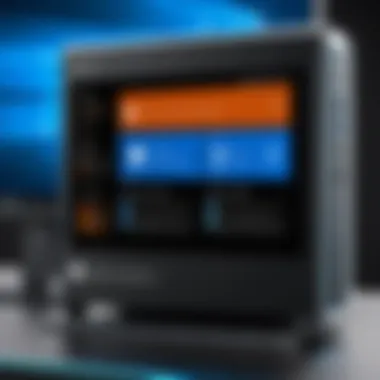Effective Strategies for Low Disk Space on Windows 10


Intro
Low disk space on a Windows 10 system can be quite a thorn in the side for many users. Whether you are running a demanding software for your job or just storing heaps of photos and videos from your last vacations, running low on disk space could feel like a ticking time bomb. It's not just a tech issue; it can disrupt your workflow and even lead to performance problems that are frustrating.
While the reasons for low disk space can vary, some common offenders include large applications, accumulated temporary files, ineffective storage management, and even those pesky unused programs. Luckily, the solutions are not as elusive as they might appear. This guide is here to dissect these challenges and provide comprehensive methods to reclaim that valuable space. We're not just throwing ideas around; we're providing actionable insights that can lead you to a tidy and efficient disk.
By the end of this piece, you should feel equipped and ready to tackle any low disk space concerns, empowered by knowledge and techniques reviewed from both practical and advanced angles. Let’s dig in.
Understanding Low Disk Space
Low disk space on Windows 10 can be a source of major headaches. To navigate around this problem effectively, it’s essential to grasp the concept of disk space itself and its implications.
Defining Disk Space
Disk space refers to the amount of storage available on a hard drive to keep files, applications, and the operating system itself. Understanding how disk space is allocated helps users manage their systems more efficiently. Each file, whether it’s a document, image, or application, takes up a certain amount of space. For instance, a high-resolution photo can occupy several megabytes, while a simple text document might only use a few kilobytes. This direct correlation affects overall system performance; as space fills up, the operating system struggles to find areas to operate efficiently.
Impact of Low Disk Space
While it may seem trivial, low disk space can have quite a ripple effect. Imagine trying to drive on an overstuffed highway; similarly, low disk space can cause your system to slow to a crawl. You might encounter unresponsiveness or lag, especially when launching applications or saving files. In severe cases, low disk space can lead to system crashes or data loss. It’s a common misconception that a little free space is enough—systems often require a certain buffer to manage temporary files, memory swapping, or updates. Hence, managing disk space is not just about cleaning up; it’s crucial for system health.
Identifying Common Causes
Knowing what leads to low disk space is half the battle won. A few usual suspects include:
- Unmonitored Downloads: Downloads accumulate over time and often go unnoticed.
- Unused Applications: We often install applications out of impulse. Over time, many sit idle yet take valuable disk space.
- Temporary Files: Software updates and everyday browsing leave behind a sea of temporary files.
- Large Media Files: High-definition videos and photos can eat away space faster than one might anticipate.
Understanding these causes helps users take proactive measures, ensuring that disk space remains manageable. Addressing the issue of low disk space not only smooths out day-to-day operations but also extends the lifecycle of the hardware.
Assessing Current Disk Usage
When dealing with low disk space issues, the first step is to aasses your current disk usage. Understanding what’s eating up your space is crucial not only for immediate fixes, but also for long-term management of your system’s resources. By effectively evaluating disk usage, you equip yourself with the knowledge needed to make informed decisions on what to keep and what to discard.
Checking Disk Space Through Settings
Windows 10 provides a straightforward method to check your disk space through its built-in settings menu. To start, navigate to Settings by clicking the gear icon in the Start menu. From there, select System and then go to Storage. You will see a graphical representation of how much space is used versus free on your primary drive.
This view goes beyond just a number; it breaks down the usage into categories such as Apps & features, Temporary files, and even System reserved. Each category is clickable, letting you drill down into specific types of files. This is particularly useful for identifying large applications that could contribute to your low disk space issue.
"Regularly checking disk usage can prevent unexpected issues as files pile up over time."
Here’s a quick recap of the steps involved:
- Click on Start and select Settings.
- Choose System > Storage.
- Review the disk usage breakdown by category.
Using Disk Management Tools
If you’re looking for a more detailed analysis, the Disk Management tool in Windows offers several advanced features. Access it by right-clicking on the Start button and selecting Disk Management. This tool displays all connected drives, their partitions, and the amount of space allocated versus unallocated.
Within Disk Management, you can also see which partitions are almost full, whether they are formatted correctly, and if they are at risk of failure due to low free space. This is notably helpful for those who run multiple partitions or external drives. From here, you can also create new partitions or delete those no longer needed.
For those comfortable with command-line tools, using the diskpart command in the Command Prompt offers even more capability to manage disks effectively.
Here’s a simplified outline to use Disk Management:
- Right-click the Start button and select Disk Management.
- Review your drives and partitions.
- Identify any space that could be redeveloped or potentially cleaned up.
By assessing your current disk usage effectively through these methods, you can pinpoint more accurately where to start when it comes to cleaning up space on your Windows 10 machine. This foundational understanding aids not just in solving existing issues, but in preventing future ones as well.
Disk Cleanup Techniques
Disk cleanup is an essential strategy in the battle against low disk space on Windows 10. Over time, as files pile up, the system loses its agility, leading to sluggish performance. It’s like carrying around too much baggage; eventually, you can't move as freely or effectively. Hence, understanding and employing disk cleanup techniques can significantly enhance system performance and free up valuable storage.


Utilizing Windows Disk Cleanup
The built-in Windows Disk Cleanup utility is a straightforward tool that allows users to identify and remove files that are no longer needed. Initiating the Disk Cleanup can be done with just a few clicks, making it accessible for even the less tech-savvy individuals. Here’s how:
- Open Disk Cleanup: Type "Disk Cleanup" in the Start menu search bar and select the application.
- Choose Drive: Select the drive you want to clean (typically C: drive) and press OK.
- Select Files to Delete: A dialog will appear listing the types of files you can remove, like temporary internet files, system memory files, and more.
- Clean System Files: For additional cleanup, you can clean system files, which often yields even more space.
Using this tool can instantly clear a significant chunk of space, and it’s a good habit to run it on a regular basis, sort of like a seasonal cleanup for your computer.
Removing Temporary Files
Temporary files can sneak in and occupy disk space without you even realizing it. These files are created by the system for various processes, but they often linger long after their usefulness has expired. Removing these can lead to noticeable improvements in available space. Here’s how to tackle this:
- Access Settings: Go to Settings > System > Storage.
- Temporary Files: Under the storage options, click on "Temporary files". Windows will calculate how much space can be freed.
- Select and Remove: Choose the types of temporary files you want to remove, then click on Remove Files.
This process doesn’t just free up space; it can also aid in improving system performance by ensuring the system isn’t slowed down by files that should have been discarded long ago.
Cleaning Up System Files
Cleaning system files isn’t just for the advanced users; it’s a necessary step if you're serious about reclaiming disk space. System files include things like Windows updates and installation files. Here's the approach to do this:
- Run Disk Cleanup as Administrator: Right-click on the Start menu and select "Windows PowerShell (Admin)". Type and hit Enter to launch Disk Cleanup with administrative access.
- Select Clean Up System Files: Once in Disk Cleanup, click on "Clean up system files". You may need to confirm your admin permissions.
- Choose System File Types: A new window will appear, offering you a list of additional file types you can remove. This often includes old Windows update files and previous installations that can accumulate over time.
It’s a bit like pruning a garden; without cutting away the old growth, you can’t make room for new blooms.
In summary, employing disk cleanup techniques is crucial for optimal Windows 10 performance. The built-in tools, while seemingly simple, offer powerful solutions to reclaiming disk space. Regular maintenance can keep your system spry, ensuring that you are always ready to take on the tasks at hand.
Managing Installed Applications
In the realm of a computer's efficiency, managing installed applications stands as a crucial pillar that can make or break the overall performance of a system. Especially for Windows 10 users, where various applications can both enrich the user experience and create clutter, understanding how to handle these installations effectively is vital. Not only does it relate to storage capacity, but it also influences system speed and responsiveness. By being proactive in managing applications, users can free up disk space, improve disk performance, and optimize their operating environment.
Identifying Disk Heavy Applications
The first step in managing applications is pinpointing which ones are hogging disk space. A simple observation could reveal the most commonly used programs, but that's not enough. To get a clear picture, utilize the built-in tools in Windows. Open the Settings app, navigate to "Apps", and check the storage usage.
You may find applications like games, video editing software, or even large development tools occupying significant storage. Use this list to take note of which applications are essential and which do little more than occupy virtual real estate on your disk.
Quick Tips to Identify Disk Heavy Apps:
- Sorting by Size: When checking installed applications, sort by the amount of disk space used.
- Using Disk Space Analyzer Tools: Third-party apps like WinDirStat can help visualize disk usage and identify large files and folders quickly.
Uninstalling Unnecessary Software
Once you have a solid grasp on which applications take up the most disk space, the natural next step is to unburden your system by removing unnecessary software. We all have those programs that were downloaded on a whim or applications that looked good at the time but now serve no purpose. Uninstalling them can free up precious space.
To streamline this process, go to "Apps and Features" in your Settings menu. You can easily remove any unwanted programs from there. However, don't just yank everything out.
Consider the following:
- Keep Essential Apps: Prioritize tools you actively use for work or personal tasks.
- Research Before Removal: Some applications are linked to other software or system functions, be cautious before deciding to uninstall.
"A cluttered disk reflects a cluttered mind; clear it out, and your system will respond in kind."
Disabling Startup Programs
Some applications, while useful, don’t need to run at all times, especially at startup. Allowing too many programs to launch upon boot can lead to longer loading times and a sluggish system. Disabling these startup programs will help in managing your disk space more efficiently.
In Windows, you can manage startup applications through the Task Manager. Press , navigate to the "Startup" tab, and review the list. You’ll see programs that commence running as soon as you fire up your machine.
- Disable Non-essential Programs: If a program doesn’t need to start immediately, consider turning it off in this list. Common candidates for this are updaters or background services that you can run manually when needed.
- Be Mindful: Make sure that critical processes needed for your system’s operation are not disabled, as this could cause issues.
By tackling installed applications diligently, users pave the way for a smoother, more efficient experience on their Windows 10 systems. From identifying disk-heavy applications and streamlining software installations to managing startup processes, these strategies can significantly enhance system performance while ensuring ample disk space.


Utilizing Storage Sense
In the grand quest for managing disk space on Windows 10, Storage Sense emerges as a vital tool at your disposal. This feature, when configured properly, helps maintain a tidy system by automating the cleanup process. Imagine being able to regularly declutter your disk without lifting a finger; that’s essentially what Storage Sense does. For busy IT professionals and tech enthusiasts, this capability can't be overstated, as it not only saves time but also helps in preventing the panic that can arise from sudden low disk space warnings.
Configuring Storage Sense in Windows
Setting up Storage Sense is a straightforward process. First, navigate to the Settings app by clicking on the gear icon in the Start Menu. Once there, head to System, and then select the Storage tab. Here, you will find the option to enable Storage Sense if it isn't already active. After toggling it on, several configuration options become available.
You can determine how frequently Storage Sense runs, be it daily, weekly, or monthly. For instance, if you often download large files for work or study, configuring Storage Sense to run more frequently might be advantageous. Additionally, you’ll find settings to control what types of files it cleans. Temporary files, recycle bin contents, and downloads that haven’t been accessed for a set period can all be part of this automated process. By tailoring these settings to your habits, you can optimize your disk space without the hassle of manual cleanup.
Automatic Cleanup Settings
Now that you have your Storage Sense set up, diving into the automatic cleanup settings can further enhance its effectiveness. This portion of the feature permits you to prespecify conditions under which files are removed. For example, you might set it to clear out files in your Downloads folder after 30 days of no activity. Thus, files that pile up and use storage unnecessarily can vanish without your daily attention.
Moreover, Storage Sense also offers an option to automatically delete files from your Recycle Bin after a designated time, such as 30 days. This is significant because many users forget to empty the Recycle Bin, leading to wasted space over time. For anyone who tends to accumulate too many files, these automatic cleanup settings can feel like having a virtual assistant ready to tidy up at a moment’s notice.
"Storage Sense isn't just a feature; it’s a game changer for maintaining your system's health while you focus on more important tasks."
In summary, Utilizing Storage Sense not only provides an automatic method for keeping your disk in shape but adapts to your specific usage patterns. By properly configuring it, you can dodge the headache of low disk space warnings, thus ensuring smoother and more efficient computing.
Optimizing File Storage
Optimizing file storage is a linchpin aspect of managing disk space efficiently on Windows 10. It's not just about clearing off some megabytes here and there; it’s a strategic approach to maintain system performance and longevity. By reducing clutter and using either external or cloud storage solutions, you can free up precious disk space and create a more organized digital workspace. This thoughtful management of files can yield significant benefits in system responsiveness and storage capability.
Moving Files to External Media
One of the easiest and most effective methods to regain disk space is by moving files to external media. This process not only addresses immediate storage issues but also assists in data preservation and accessibility.
External hard drives and USB flash drives are excellent choices for offloading files you don’t need daily access to. For instance, large media collections, extensive project files, or old documents can clutter your main storage, yet keeping them handy in an external device ensures you can retrieve them, but they’re not hindering your operating system's performance.
It’s essential to properly categorize files that are transferred. Use descriptive folder names and consider organizing by date or project to make retrieval easier in the future. The idea is to flip the script on your disk usage – keeping in mind what you use regularly as opposed to what can sit safely in storage for later use.
Here are a few steps to consider when moving files to external media:
- Select a reliable external device: Ensure it has sufficient capacity and offers good data transfer speeds.
- Back up important files: Use both an external drive and a secondary source, like cloud storage, in case of device failure.
- Regularly transfer and organize: Make it a regular habit to move files that are no longer needed in your daily workflow.
Leveraging Cloud Storage Solutions
Cloud storage is another robust strategy for managing files and optimizing your on-device storage in Windows 10. Services like Google Drive, Dropbox, and OneDrive allow you to store files off your local drives, which not only secures them from physical damage but also frees up disk space.
By employing cloud solutions, you can easily categorize files and access them from multiple devices. This is particularly useful for professionals who may work from various locations. If a file is needed, you can access it without having to tote around external hard drives. Moreover, most cloud services offer automatic backup features, reducing the risk of data loss should your hardware experience a failure.
In the interest of security, however, it’s advisable to encrypt sensitive files before uploading them. This ensures that even if unauthorized access occurs, your information remains protected. Additionally, evaluating how much data you store in the cloud will help you choose the right plan according to your usage.
Organizing Files Effectively
An often overlooked aspect of optimizing file storage is the organization itself. Efficiently categorizing and managing your files can significantly impact how you utilize your disk space. Think of it this way: a tidy digital workspace saves time and effort when searching for important documents or files.
When it comes to effective organization, consider the following practices:
- Utilize folders and subfolders: Group similar files together to reduce clutter and make navigation simpler.
- Implement a naming convention: Establish clear and consistent file naming norms that convey content and relevance, using dates or versioning where appropriate.
- Regularly review and purge: Make it a routine to revisit your files every few months to eliminate duplicates or outdated information that no longer serves your needs.
"An organized file system often translates to an organized mind."
By embedding these practices into your daily routine, you’ll not only maximize your storage efficiency but also pave the way for smoother overall system performance. As systems tend to slow when overloaded with unnecessary files, staying ahead of the game with proactive organization can make all the difference.
Advanced Disk Management Tools
Managing disk space on a Windows 10 system can be likened to watching a pot of water – you can avoid burning it by keeping an eye on it instead of waiting for it to boil over. Utilizing advanced disk management tools is crucial, as they can provide deeper insights into your storage usage and offer solutions that are not immediately evident through standard methods.
Exploring Third-Party Utilities


While Windows offers built-in options for managing disk space, sometimes you need to bring out the big guns. Third-party utilities, like CCleaner, WinDirStat, or TreeSize, can be invaluable allies in the fight against disk clutter. These tools often come packed with features that allow for more granular control over disk usage, going beyond simple file deletions.
- Detailed Storage Analysis: Utilities like WinDirStat visualize disk usage, allowing you to see which files or folders are hogging the most space at a glance. This can help you identify items that may have slipped under your radar.
- Automated Cleanup Functions: Many tools offer scanning capabilities that can automatically find and remove temporary files, old backups, and other unnecessary data. This can free up substantial disk space without manual labor.
- Safe Uninstallation of Applications: Applications like Revo Uninstaller not only remove software but also eliminate leftover files and registry entries that often go unnoticed.
However, exercising caution is essential when using third-party options. It’s vital to ensure that the software is from a reputable source to avoid exposing your system to potential risks.
Using Command Prompt for Storage Management
For those who prefer a more manual approach or have hunched backs from troubleshooting, the Command Prompt serves as a powerful tool for managing storage. It’s not the flashiest option, but its efficacy can’t be understated. Some commands, albeit a bit particular, can help you sift through and manage disk usage efficiently.
- Viewing Disk Space: You can access a quick overview of your current storage status by opening Command Prompt and typing:This command gives you a clear breakdown of used and available space on each disk.
- Cleaning Up with Disk Cleanup:
Triggering the built-in Disk Cleanup tool through Command Prompt is also an option. Simply input:You’ll see a prompt where you can select the drive and proceed to eliminate unwanted files. - Using Diskpart for Managing Partitions:
For the more technically inclined, offers advanced options to delete, format, or create partitions. This level of management can be beneficial, but be warned – it’s easy to mistakenly erase essential data if you’re not careful.and then navigate with commands to manage your disk.
Remember, with great power comes great responsibility. Errors in the Command Prompt can lead to catastrophic data loss, so proceed with utmost caution.
In summary, advanced disk management tools, whether they are third-party utilities or command prompt methods, are essential for maintaining optimal disk health on systems running Windows 10. By leveraging these tools, IT professionals can ensure a more organized and efficient storage environment, which ultimately supports better system performance.
Preventative Measures
Addressing the issue of low disk space on Windows 10 is not just about quick fixes; it's also about establishing a proactive strategy. Preventative measures play a crucial role in maintaining a well-functioning system. By putting certain practices into place, users can avoid the headache of dealing with low disk space in the first place. Not only do these practices save time, but they also contribute to overall system efficiency and longevity.
When it comes to disk space, the old adage rings true: an ounce of prevention is worth a pound of cure. Rather than waiting for space to dwindle to critical levels, regular habits like monitoring disk usage and organizing files can make a significant difference.
Regular Monitoring of Disk Space
Regularly checking your disk space can prevent unexpected storage issues down the line. This might sound like a chore, but it's quite straightforward. Users can set reminders to check their storage once a month or set their systems to notify them when disk usage reaches a certain threshold. Windows 10 even has built-in tools that make this task easier, allowing you to track your disk space usage seamlessly.
By keeping tabs on disk space, you'll be better equipped to act before the situation gets dire. This practice not only helps in recognizing trends but also in identifying which applications or files consume the most space. Here are a couple of strategies:
- Use Built-in Tools: Go to Settings > System > Storage to get a quick overview of what's eating up your storage.
- Set Notifications: Use tools or scripts that alert you when storage space dips below a certain point.
Implementing Efficient Data Management Practices
Efficient data management is more than just a buzzword; it’s a vital approach to ensuring you don't run into disk space issues. This can involve everything from organizing files systematically to using cloud storage solutions. One aspect users often overlook is the importance of having a structured file system.
Consider the chaos of a cluttered bookshelf; it’s hard to find what you need. Similarly, a disorganized digital space can lead to wasted time and potential storage issues.
To cultivate efficient data management, here are some practices:
- Create a Logical Folder Structure: Start a clear system of folders and subfolders. Group similar files together, making it easier to find and evaluate what you need to keep.
- Regularly Review Files: Allocate time—perhaps quarterly—to delete files that are no longer needed. This review can also include archiving old projects to external storage or the cloud.
- Use Cloud Services: Services like Google Drive or Dropbox can significantly reduce local storage anxiety. By transferring less frequently accessed files to the cloud, you can maintain easier access while freeing up space.
Implementing these practices will not only help manage disk space better but will also foster a more organized digital workspace. Just remember, a little management goes a long way in preventing low disk space issues from rearing their ugly heads.
Ending
In wrapping up this article, it’s crucial to recognize that managing low disk space on Windows 10 is not merely a technical task—it's an essential practice that can significantly enhance the performance and longevity of your system. An adequately maintained disk not only improves processing speed but also prevents the aggravation of software malfunctions which might arise from insufficient memory.
Summarizing Key Strategies
Throughout our exploration of this topic, several key strategies have emerged that are pivotal for effective disk space management:
- Consistent Monitoring: Regular checks on disk usage can be like checking your fuel gauge before a long drive. Using tools available in Windows, such as settings and Disk Management, helps keep an eye on how much space is available and what is consuming it.
- Implementing Disk Cleanup: Utilizing tools like Windows Disk Cleanup can be a game changer. It effectively clears out temporary files, system files, and other unnecessary clutter, leaving behind a cleaner and more efficient environment.
- Effectively Manage Software: Uninstalling applications that go unused and disabling unnecessary startup programs can free up substantial space and resources, helping the system to run smoother.
- Optimizing File Storage: Strategies such as moving files to external drives or utilizing cloud solutions are fundamental today. Not only do these methods prevent storage challenges, they also provide a fail-safe against data loss.
- Advanced Tools: Exploring third-party utilities and even delving into Command Prompt can offer deeper insights and management capabilities that standard methods sometimes miss.
Incorporating these approaches regularly can mitigate the headache of low disk space issues and keep your Windows 10 system running at its full potential.
Encouraging Best Practices
To sustain this optimal environment, consider nurturing certain best practices:
- Develop a Cleaning Routine: Much like cleaning your house, setting a routine schedule for digital maintenance yields better results over time. Regular disk clean-ups and software audits should be part of the schedule.
- Educate Yourself: Staying informed about the latest tools and techniques can empower you to tackle disk management more efficiently. Get involved in community discussions, like those on Reddit, or check out helpful resources on Wikipedia.
- Backup Important Data: Preserving your essential files by backing them up is crucial, especially before making significant changes or clean-ups.
- Be Mindful of Downloads: Often, large files accumulate without notice. Be attentive to downloads and review them periodically to avoid letting them eat up your precious disk space.
Conclusively, ensuring your Windows 10 system runs seamlessly amidst continuous digital demands requires a proactive mindset toward management and organization. Implementing the strategies and practices detailed in this article provides a solid groundwork for optimal storage management. 🖥️ If you actively engage with these methods and integrate them into your daily computing habits, you'll experience a noticeable improvement in your system's performance.







